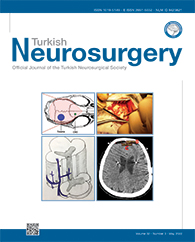2Tokyo Women?s Medical University, Department of Neurosurgery, Tokyo, Japan DOI : 10.5137/1019-5149.JTN.35036-21.3 AIM: To analyze the clinical characteristics of thoracic ossified ligamentum flavum (OLF) and clarify prognostic factors.
MATERIAL and METHODS: We retrospectively collected clinical data from the medical records of 29 patients who underwent decompressive surgery for myelopathy caused by thoracic OLF from 2011 to 2019. Associations between various clinical and radiological factors and surgical outcomes were analyzed.
RESULTS: The mean preoperative and final follow-up modified Japanese Orthopaedic Association scores were 6.7 and 7.9 points, respectively (mean follow-up period, 22.4 months; p<0.0001). Univariate analysis revealed that preoperative symptom duration and postoperative epidural hematoma on magnetic resonance imaging (MRI) were significant surgical outcome predictors. The recovery rate was higher in patients without postoperative epidural hematoma (n=16) than in those with postoperative epidural hematoma (n=13; 38.7% ± 28.1% vs. 12.9% ± 24.4% mm; p=0.01). Multiple regression analysis showed that postoperative epidural hematoma on MRI was a significant surgical outcome predictor (p<0.05).
CONCLUSION: Posterior decompressive laminectomy and resection of OLF can be considered effective. Postoperative epidural hematoma on MRI may be an important surgical outcome predictor.
Keywords : JOA score, Postoperative epidural hematoma, Recovery rate, Thoracic ossified ligamentum flavum




